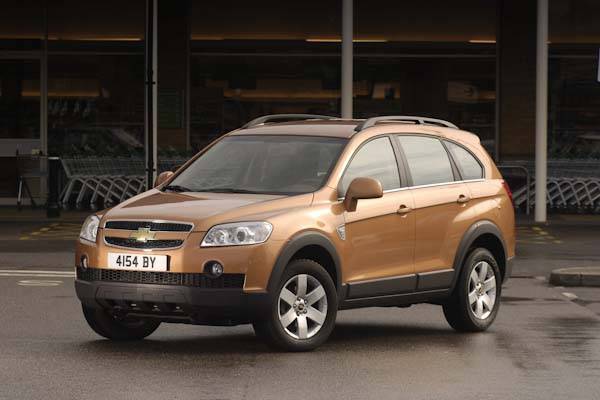
RAC sale – up to 33% off*
• Roadside cover from £5.29 a month†
• We get to most breakdowns in 60 mins or less
• Our patrols fix 4/5 breakdowns on the spot

BY STEVE WALKER
Introduction
4x4 vehicles might form an integral part of virtually every mainstream car manufacturer's model range these days but it wasn't always so. Retreat through the annals of history for a few years and the 4x4 was a more specialist proposition that comparatively few manufacturers paid much attention to. One hangover from this era, for people who remember it, is that certain badges sit more comfortably on the nose of a 4x4 than others. Land Rover, Jeep and the big Japanese names all have longstanding pedigrees in the field and are names that seasoned buyers will trust. Chevrolet does too, even if it may have escaped many in the UK, and that could bode well where its Captiva compact 4x4 is concerned.
Models
Models Covered: 5dr SUV : [2.4 petrol, 2.0 CDTi diesel (LS, LT, LTX)]
History
Chevy pick-up trucks like the S-10 and Silverado, along with SUVs carrying the Blazer and Suburban badges, are massive in America - that's in both senses of the word. They've been household names since the early 80s and while they were never sold officially in the UK, they do indicate an element of 4x4 expertise on Chevrolet's part. Admittedly, it was large, profligate vehicles in this mould that were latterly responsible for leading parent company General Motors into a spot of financial bother but the Chevrolet Captiva is on a far more reasonable scale designed to tally with European sensibilities.
The Captiva was launched in 2007 a little in advance of the arrival of its sister vehicle, the Vauxhall Antara. It was a larger and consequently more practical proposition than most of the rival compact 4x4 models on the market at the time and the roomy cabin allowed the inclusion of two extra seats in the back of higher spec models. With a seven-seat capacity, the Captiva had the ability to crossover into the market for larger family 4x4s and a distinct edge over many of the compact 4x4 alternatives.
The car was launched with a 2.4-litre petrol engine and a 2.0-litre CDTi common-rail diesel that originated from the Vauxhall stable and was to be the big seller. LS, LT and LTX trim levels were offered with the LT and LTX having the seven-seat option and the LS offered only in front-wheel-drive form. An Ikon special edition model was launched in 2009 bringing a package of styling accessories and extra equipment at a reduced price.
What You Get
The Captiva isn't one of these SUVs that tries to smooth over its styling in a bid to look more like a conventional car. All the tell-tail 4x4 styling devices are present, from the cavernous wheelarches to the chunky bumpers and big chrome grille. The design is clever in reducing the perceived bulk of what is a surprisingly spacious vehicle. Viewed in isolation, the Captiva looks to be about the size of a Toyota RAV4 or a Suzuki Grand Vitara but the tale of the tape shows that it's a much heftier piece of metalwork. For a start, it's fully 4,639mm long, compared with the 4,415 of the Toyota and the 4,470mm of the Suzuki. That's why the Chevy has room for three rows of seats in some versions.
The Captiva's rear seats are usable too, that's by fully-grown people with a full complement of limbs. As an adult of six feet tall, you'd need some considerable powers of endurance to sit out a long journey in the third row but you could do it, unlike in many of the Captiva's rivals. For kids, the space is generous. In the five-seat versions or with the rear seats folded, there's a 465-litre luggage capacity and by folding all of the back seats down, it's possible to fit a huge 1,565 litres of stuff inside. General build quality around the cabin is also pretty good and certainly better than you'll find in some of Chevrolet's smaller passenger car offerings.
The suspension layout consists of a MacPherson strut configuration in front and an independent four-link design in the rear. Ventilated disc brakes are standard on all four wheels. The Captiva's 4x4 set-up is an on-demand system, meaning that as driving conditions require, the rear axle is instantly activated via an electromagnetic coupling to give maximum traction through all four wheels. The set-up also seamlessly interacts with the ESP and ABS systems, enhancing driver control of the vehicle and safety margins. The ESP itself has additional functions like HBA (Hydraulic Brake Assist), HDC (Hill Descent Control) and ARP (Active Rollover Protection).
What You Pay
Please fill in the form here for an exact up-to-date information.
What to Look For
What you don't want is a Chevrolet Captiva that's been owned by a forest ranger or some Ray Mears wannabe who's driven it to the brink of destruction on a weekly basis. In truth, the Captiva isn't the kind of 4x4 that's likely to attract the hardcore off-road driver but just in case, check the alloy wheels for excessive damage, have a look underneath the car to ensure the exposed areas are clean and abrasion free and avoid any seller decked out in army surplus camouflage fatigues whose other car is a Chieftain tank.
Replacement Parts
(Approx - based on a Captiva 2.4 LS) Consumables for the Captiva are reasonably priced, an air filter retailing at around £11, a fuel filter costing around £21 and an oil filter £9. Spark plugs are £5 each and a new cam belt adds up to approximately £60.
On the Road
The engine range kicks off in unspectacular style with the rather aged 2.4-litre petrol engine, then perks up considerably with the 2.0-litre VCDi diesel. Crucially the entry-level cars are front wheel-drive only, the decision to forgo the complex and weighty 4x4 system doing much to keep running costs down. The front-wheel-drive versions feel little different from the 4x4s, which run in front-wheel-drive mode until traction is lost anyway, and will be fine for buyers intending to stick to light duties on the tarmac. Owners intending to tow or who regularly tackle adverse weather conditions will feel the benefit of the 4x4 system and it's a must of course if you're heading off-road. There's a 2,000kg maximum towing limit on the 4x4 cars.
The petrol option has 133bhp and will detain you for 11.5s while it zips up to 60mph. The front-wheel-drive diesel has 150bhp and a 10.8s 0-60mph time, which is half a second quicker than a four-wheel-drive Captiva fitted with the same engine. Combined economy is 32mpg for the petrol and 38 or 39mpg for the diesel depending on the drive system.
The Captiva isn't the most nimble thing on the road but it has decent ride quality for a 4x4 of its size. An automatic gearbox option was offered with the diesel engine in the higher trim levels but it reduces economy to 33mpg and takes the edge off performance.
Overall
Chevrolet has quite a history when it comes to 4x4 vehicles but the Captiva has little in common with the behemoths that the brand became associated with across the pond. It's a sizable car by our standards and the roomy cabin is probably its major strength, especially with seven seats installed. The diesel engine is a good one but the petrol isn't and is best avoided. Build quality should throw up few problems and the ride comfort is a plus, even if this isn't one of the best handling compact 4x4s around. Buyers seeking a big and practical family vehicle should get on well with a used Captiva, particularly considering the prices at which it's now available.







![BMW X1 [F48] (2019 - 2022) used car review](https://d1ix0byejyn2u7.cloudfront.net/drive/images/made/drive/images/remote/https_d2yv47kjv2gmpz.cloudfront.net/filestore/2/1/6_15f694c57c4c37b/1af6c75561b7358a16687e39de0adaec/612_40ce839b374978d_100_100_70_c1_c_c.jpg)